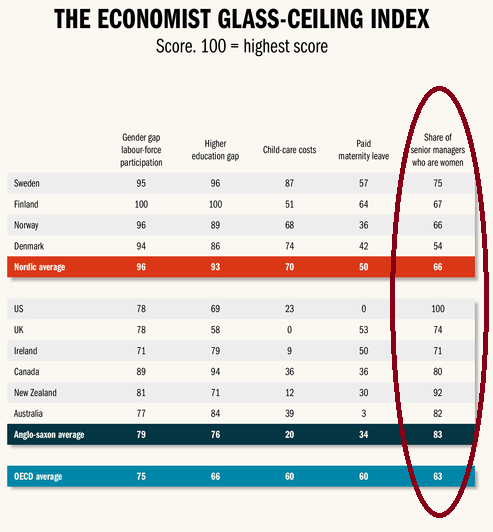As I have shown in two previous columns for CapX, Nordic countries seem to have it all when it comes to gender equality. Yet, although these countries have arguably the most gender equal norms in the world, they fail to live up to their feminist potential. The reason is that Nordic-style welfare states are (un)intentionally holding women back from reaching the top. An equally important point is that Anglo-Saxon style capitalism is better at empowering women than what is often assumed.
The Economist has compiled a glass-ceiling index, in which various countries around the world are compared in terms of the opportunities granted to women. As shown below, at a first glance it would seem that the Nordic countries outshine the Anglo-Saxon ones when it comes to breaking the glass-ceiling.
When it comes to issues such as the labour force participation difference between genders and the higher education gap, the Nordics are consistently placed at the top of The Economist index. In Finland for example men only have 2.5 per cent higher labour force participation than women. The gap is twice as large in the US and four times as large in the UK. Child care cost and paid maternity, services provided largely by the public sector in the Nordic welfare states, can in part explain the high labour participation amongst both parents. Such systems are more extensively funded by the public sector in the Nordics compared to other modern economies, and particularly so compared to the Anglo-Saxon nations.

In the UK for example the cost for families of child care amounts to fully 46 per cent of an average wage. In the US it is somewhat lower at 35 per cent. Compare this with Sweden, where the cost is paid mainly through taxes and the public sector, leaving parents to pay 6 per cent of an average wage for child care. Public financing of maternity leave is another good example. In Finland maternity leave is paid 14 weeks based on 100 per cent of last earnings. In the UK less than 12 weeks are paid based on the full income, whilst the US stands out by having no universal public system of parental leave.
The conditions for woman’s careers, according to the parameters listed by The Economist, seem to be impressively good in the Nordics. How well do they then perform if we look at the actual measure of breaking the glass-ceiling, that is, the proportion of women who reach the top? To get the answer, we need to look at the part of the index which actually is about the share of women who reach the top. I have marked this part in the image below. As it turns out, the Nordic superstars score just above the OECD average when it comes to the share of senior managers who are women, and are on average far behind the Anglo-Saxon countries.

The US tops the league with 43 women managers. The average Anglo-Saxon economy has 37 per cent women managers. The Nordics on average only have 31 per cent. We see here that there is something lacking in Nordic gender equality. These societies are better in theory than in practice at breaking the glass ceiling.
On the other hand, the US has far more women who reach managerial positions than other modern economies. I show this in another image below. As we can see, the average women is more than twice as likely to reach a managerial position in the US than in the average modern OECD economy.

It might seem odd that the United States, a country with no universal public system of parental leave, has unusually high level of women reaching the top. How do American women manage to do this, without the help of the welfare state? The simple answer, which I deal with more in detail in The Nordic Gender Equality Paradox, is that large welfare states are not as good in promoting women’s upward mobility than what is often assumed.
In part the welfare systems do encourage a high labour participation amongst women, not least by providing child care. The other side of the coin is that public monopolies on health, education and elderly care, generous public handouts and generous paternal leave benefits all add up in encouraging women not to work many hours. Part-time work is quite common amongst women in Nordic welfare states, simply because the system encourages this. In those families where both spouses wish to invest many hours in the workplace, high taxes make it difficult to buy services needed to substitute for household work. The Nordic solution is often for the women to be a part-time worker and part-time housewife.
Certainly those American women who reach managerial positions have to struggle reaching there, often having a greater challenge balancing responsibilities for home and work than their male peers, and often facing discrimination. But they do manage to reach the top. And in the competitive capitalist economy, where sectors such as health care where many women work are not part of government monopolies, employers have to compete for the talent of women or otherwise loose out to their competitors.
Arguably, free markets are a force for promoting gender equality. If the Nordic countries – with their uniquely gender equal cultures and history – where to adapt a bit more of Anglo Saxon style capitalism, perhaps they would have greater success in breaking the glass-ceiling.


